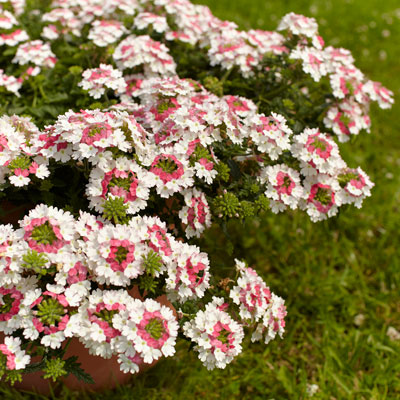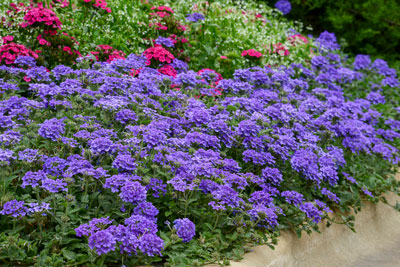11/1/2023
A Friend in Verbenas
Lowell Halvorson
Over the past two decades our industry has turned toward combo baskets in a big way and no crop has benefited from this trend more than verbena. Like the reliable best friend in a sitcom, everyone expects to see it. In addition, verbena is popular in the retail channel, finding a place in home garden beds. For these reasons, its paycheck usually lands in the Top 10 among the annuals.
However, the famous faces had a tortured past. “I grew up with verbenas that would turn white overnight,” said one broker. “I don’t know if a lot of the newer growers even think about that because they’ve had good verbenas for quite a few years. You go back 20 to 25 years and there were definitely problems out there.”

Lanai for color range
Series Breakdown: 4 Compact | 19 Standard | 9 Up (upright) Twister bicolors appear inside all three
Introduced by Goldsmith two decades ago and nestled in Syngenta today, Lanai brought effective mildew resistance to the category and gave it traction in the industry. The series took the risk out of the crop and made sales more reliable. Its dominance shows clearly what a good verbena should do.
Pictured: The broad color range and long history of Lanai makes it a default series for basket work.
Lanai has one of the biggest color ranges in the market today—an important detail in color-first work, with a wide assortment of pinks, lots of purples, several reds and a quirky collection of bicolors. Best-selling colors are White, Bright Eye and Peach, with a couple of the Twister varieties popping up in the Top 10.
These small globes of complex texture play counterpoint to the larger, stronger solids of A-list cultivars that anchor a combo. Culturally, the plant is chill with the fussier regimes of its roommates. Lanai is the safe, well-documented, deep history solution when you want to stick to known products with known results.
Superbena for summer performance
Series Breakdown: 8 Solid | 2 Sparkling (bicolor) | 3 Royale (compact) | 2 Burst (star pattern) | 2 Extra Large (Large Lilac and Pink Cashmere)
On the market for about 10 years, Superbena is a third generation series after Tapien and Babylon. The house style of Proven Winners favors bigger, better, bolder displays, so the heftier plant has legs where lifespan is concerned.
Spring is easy for the genus, but the number of weeks a verbena can keep downy mildew at bay is still a modern problem. The longer the plant resists the disease, the better its long-term seasonal performance. Trial gardens in August and September show the issue up close.
Superbena also tightens up on verbena’s second historical knock: color-cycling. Instead of going in-and-out of color, Superbena goes into color more frequently, overlapping the waves to extend the visual appeal of the garden.

EnduraScape for landscapes
Series Breakdown: 6 Solid | 2 Fizz (bicolor) | 2 Eye
In landscapes, simplicity helps and complexity hinders, so EnduraScape from Ball FloraPlant offers a limited color selection. Color choices are midway down the list, somewhere after vigor, reliability, resistance, durability and color season. Landscapers don’t want six pinks as a rule of thumb, just one good one.
Pictued: The EnduraScape series has simple clear colors with big plants optimized for garden work.
The series is known for its vigor in the ground, tolerance for summer heat and ability to fend off late-season downy mildew. Big plants, strong stems and large flowers greatly expand both the fluff in the bed and the length of time the bed stays fluffed.
Verbena finds sales in home gardens as well, but the number wobbles with regional tastes. Landscape sales have a different curve than baskets. Basket work is rocket work—high volume earned in a few tight weeks. Revenues for landscape verbenas lope along, rising toward the start of summer, then deflating down to replenishment numbers.
The new kids on the block: The Vanessas
Series Breakdown: 9 Standard | 13 Compact | Bicolors are scattered throughout the two
Only on the market for about five years, the two Vanessa series double down on color density, defined as flower size, flower count and flower position. Both Vanessas provide color coverage by generating buds constantly. As one bloom rises above the foliage, another one is cracking underneath it. Dig a little deeper and you’ll see a third bud forming just below that one. Color never disappears because the plant is always cycling into color.
An interesting second feature is a lack of overzealous vigor. Danziger didn’t want to break that harmonious relationship found in the combos, so they bred the Vanessas to hit the Goldilocks zone. You can also see this trait in the greenhouse trays where Vanessas focus on bulking up over the plug. This reluctance to stretch can be traced to their stance. Plants tend to fill out, then up, spreading their stems to support the flower load above them.
A third aspect is a level height to all the colors. Danziger wants growers to plan different colors in and out of baskets or bring a pot crop to market as a mega-block with a minimum amount of regime changes. Better quality with less work is their point here.
All these traits are backed by maximum disease resistance, one of the first things Danziger likes to discuss. Whether you should use the Standard or Compact will depend on your requirements. The two have similar habits and vary only by a couple of inches in size. These small differences help dial in the right height for basket blooms or the slightly overflowing muffin-top finish for pots.
A southern treat: Cake Pops
For southern accounts, look at Proven Winners' Cake Pops series, a different beast of a verbena. Think of it as a lantana work-alike: shrubby herbaceous plants loaded with frilly globe-like flowers, but pastel. In the summer, they drink heat and convert it to color. In the winter, they can be perennial if it’s mild. GT
Lowell Halvorson is a consultant and writer in Fairfield, Connecticut, for retail and wholesale horticulture, specializing in business development. He also covers the breeding community for GrowerTalks magazine. You can contact him at (203) 257-9345 or halvorson@triadicon.com.